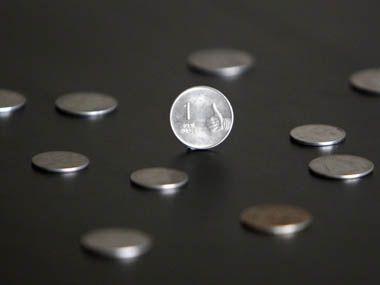Further decline in currency could offset some of the gains from lower crude oil.
 Oil prices are down, markets have hit a new high and foreign investors are queuing to invest in India's equities and debt.
Oil prices are down, markets have hit a new high and foreign investors are queuing to invest in India's equities and debt.
Though GDP growth slowed from 5.7 per cent in the June quarter to 5.3 per cent in the September one, nobody is doubting the achche din story.
The Indian rupee has outperformed most other emerging-market currencies even after the US Federal Reserve wound up its quantitative easing programme.
And, even as the US greenback appreciated against a basket of other currencies, the rupee remained largely stable.
The steady downward pressure on the rupee tell a story of its own. The rupee has depreciated 2.35 per cent in the past three months and one per cent in the past month, despite strong capital flows and falling oil prices.
One reason for this is that unlike previous years when strong capital flows came into equities, this time a larger share of the $40-billion foreign institutional investment has gone into debt, which further weakens India's external sector.
Dipankar Mitra of Motilal Oswal Securities says: "The apparent stability of rupee masks the build-up of few risks. Capital flows are lopsided towards debt thus resulting in higher external indebtedness. High interest rates are attracting arbitrage flows."
"Lastly, forex exposures of corporates are rising prompting the Reserve Bank of India (RBI) to issue repeated warning about their un-hedged positions."
RBI has adopted a fairly liberal capital flows policy and opted to keep the rupee stable than letting it depreciate to levels closer to its fair value.
The real effective exchange rate suggests the rupee is over-valued by six per cent. Since India needs to build up its forex reserves through capital flows, the exchange rate stability has been maintained along with the high interest rate differential with other developed economies.
Dhananjay Sinha, head (institutional equities) at Emkay Global, believes stronger US dollar is generally accompanied by weakening in crude prices, other commodities and emerging-market currencies.
"A 10 per cent decline in global non-fuel commodity prices decreases WPI (wholesale price index) inflation by 70-90 basis points and WPI non-food inflation by 50 basis points."
" Decline in global commodity prices is often accompanied by weakening in the rupee against the dollar. Every 10 per cent depreciation in the rupee against the dollar would imply an upside of 60-80 basis points on WPI inflation. CPI inflation is seemingly more dependent on domestic factors."











